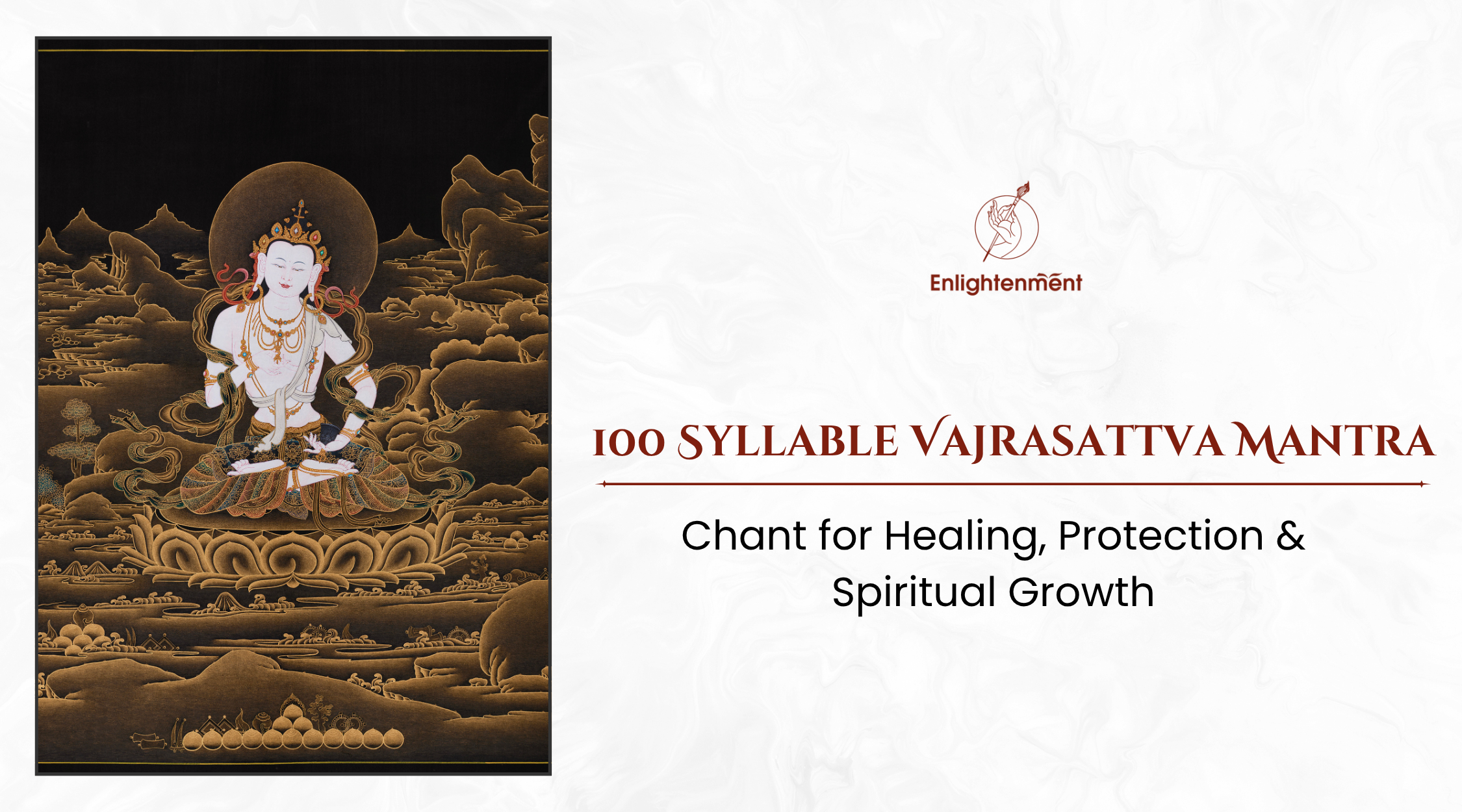Disclaimer: This article presents information on the 100-Syllable Vajrasattva Mantra, gathered from trustworthy and traditional sources. It is offered to support those engaged in the practice of Vajrasattva. For individual advice or detailed instruction, please consult your spiritual teacher or a qualified guide.
Vajrasattva is the Buddha of Purification in Tibetan Buddhism
The 100-Syllable Vajrasattva Mantra is a key purification practice, especially in the Jonang school of Tibetan Vajrayana tradition. This mantra is seen as a powerful tool for purification, healing, and protection, which helps practitioners to clear away negative karma and navigate obstacles on their spiritual journey. It is also often included in the preliminary practices known as Ngöndro, playing a crucial role in getting the mind and body ready for deeper meditation and more advanced spiritual work.
As Vajrasattva, the Buddha of Purification (Tibetan: Dorje Sempa), embodies the pure essence of the mind and the unbreakable truth, his mantra is chanted with much reverence. He is typically depicted as a white Buddha, holding a vajra, which symbolizes unwavering truth and compassion, along with a bell that represents wisdom. By meditating on and reciting on his 100-Syllable mantra, practitioners believe they can cleanse their negative karma, resolve inner turmoil, and move closer to spiritual freedom and enlightenment.
The 100-Syllable Vajrasattva Mantra
The full mantra is as follows:
OM VAJRASATTVA SAMAYA MANUPALAYA VAJRASATTVA TENOPA TISHTHA DRIDHO ME BHAVA SUTOKAYO ME BHAVA SUPOKAYO ME BHAVA ANURAKTO ME BHAVA SARVA SIDDHIM ME PRAJAYA ME VYAPAYAN CHA ME MANTRA PALEDI TISHTHA VAJRA SAKTI ME BHAVA AH
This mantra is made up of 100 syllables, and each section serves to call upon the purifying energy of Dorje Sempa. Their meaning is both deep and specific, with every syllable symbolizing a unique element of purification, invocation, and protection. Below is a breakdown of the mantra's elements:
1. OM VAJRASATTVA SAMAYA
This is the opening invocation that calls upon Vajrasattva. The sound "OM" serves as the universal seed syllable, embodying the essence of the universe, while "Vajrasattva" signifies the deity of purity. The term "Samaya" refers to the sacred vows or commitments made by the practitioner, and this mantra aims to align the practitioner with Vajrasattva's vows for the purpose of purification.
2. MANUPALAYA VAJRASATTVA
Here, the practitioner is calling upon Vajrasattva for protection. The term "Manupalaya" signifies a plea for safety and preservation, while "Vajrasattva" highlights the deity’s incredible ability to purify.
3. TENOPA TISHTHA DRIDHO ME BHAVA
This phrase is a heartfelt request for the Vajra deity to stay strong and present in the practitioner's life. "Dridho" conveys a sense of firmness or unwavering strength, while "me bhava" speaks to the practitioner's mind or essence. Essentially, this part of the mantra is asking Vajrasattva to be deeply woven into the practitioner's practice, offering a solid foundation and support.
4. SUTOKAYO ME BHAVA SUPOKAYO ME BHAVA
This section conveys a heartfelt desire for Vajrasattva Buddha to fill the practitioner's mind with virtue and wisdom. The phrases "sutokayo" and "supokayo" highlight the idea of the practitioner's mind being enriched and fortified, leading to a greater abundance of virtue and blessings.
5. ANURAKTO ME BHAVA
This section highlights Vajrasattva’s deep care and affection for the well-being of the practitioner. It emphasizes the bond between the practitioner and the Vajra Buddha, portraying him as a wellspring of compassion and unconditional love.
6. SARVA SIDDHIM ME PRAJAYA ME
"Sarva Siddhim" signifies the achievement of all goals, whether they are everyday tasks or spiritual aspirations. On the other hand, "Prajaya" embodies the pursuit of spiritual wisdom, ensuring that every goal a practitioner sets on their spiritual path is realized with the guidance and protection of Vajrasattva.
7. VYAPAYAN CHA ME MANTRA PALEDI TISHTHA
The practitioner asks Dorje Sempa to provide blessings and keep obstacles away, "Vyapayan" refers to the removal or dispelling of hindrances. "Mantra Pale" refers to the safeguarding of the mantra and spiritual practices, and "Tishta" again asks for the firm establishment of Vajrasattva’s influence in the practitioner's life.
8. VAJRA SAKTI ME BHAVA
"Vajra Sakti" refers to the powerful energy or "vajra power" of Vajrasattva. This is the invocation for Vajrasattva's indestructible strength to enter the practitioner’s life and mind, reinforcing their determination, wisdom, and courage.
9. AH
The final syllable "AH" symbolizes the utterance of wisdom, representing the completeness and perfection of the practice. It’s the culmination of the mantra, symbolizing the transformation of the practitioner into a pure state of mind, free from all defilements.
The Spiritual and Healing Benefits of the 100-Syllable Vajrasattva Mantra

The 100-Syllable Vajrasattva Mantra has several profound benefits for practitioners, as it cleanses negative karma, heals emotional and mental wounds, and accelerates spiritual growth.
1. Purification of Negative Karma
The Vajrasattva Mantra holds incredible power, especially when it comes to cleansing away negative karma that we've built up over time. When someone dedicates themselves to reciting this mantra, it's believed they can wash away past misdeeds, harmful words, and unkind thoughts. This process of purification is crucial for anyone on a spiritual journey, as it helps remove the barriers that stand in the way of reaching their true potential.
2. Healing of the Body, Mind, and Speech
This mantra not only purifies negative karma but also has healing properties for the body, speech, and mind. It is believed that repeating the mantra regularly can restore physical health, calm the mind, and cleanse harmful speech patterns. This healing process extends to both the individual and their environment, as it brings balance and peace to all aspects of life.
3. Protection from Obstacles
Reciting the 100-Syllable Vajrasattva Mantra is a powerful practice that offers protection against both external and internal challenges. These challenges can come in many forms, such as negative influences from our surroundings, harmful emotions like anger or jealousy, or even our own fears and doubts. The mantra serves as a protective shield, guiding and safeguarding the practitioner on their spiritual journey.
4. Spiritual Growth and Awakening
The 100-Syllable Mantra facilitates rapid spiritual growth. It helps to purify the practitioner's karma, clear the mind, and boost wisdom, all of which speed up the journey toward enlightenment. Many believe this mantra is crucial for deepening one's understanding of reality and strengthening their connection to the teachings of the Buddha.
How to Practice the 100-Syllable Vajrasattva Mantra
To derive the full benefits of the 100-Syllable Vajrasattva Mantra, it is important to practice it with sincerity and devotion. Here’s how you can incorporate it into your spiritual practice:
1. Preparation
-
Find a quiet, distraction-free space.
-
Sit comfortably and relax your body.
-
Focus on your breath to calm and center the mind.
2. Take Refuge
-
Mentally take refuge in the Three Jewels:
-
Buddha (the teacher)
-
Dharma (the teachings)
-
Sangha (the spiritual community)
-
-
Establish a sincere intention and reaffirm your commitment to the path of enlightenment.
3. Recite the Mantra
-
Begin chanting the Hundred Syllable Vajrasattva Mantra, aloud or silently.
-
Recite each syllable mindfully and with devotion.
-
Visualize Vajrasattva above your head, radiating pure white light.
-
Imagine the light dissolving negativity, purifying your body, speech, and mind.
4. Dedicate the Merit
-
At the end of your recitation, dedicate the merit of your practice:
-
Wish for all sentient beings to be free from suffering.
-
Aspire that all may progress toward awakening and enlightenment.
-
5. Repeat Consistently
-
Make this a regular part of your spiritual routine.
-
Start with a few recitations each day and gradually increase.
-
Consistent practice deepens purification and builds inner clarity.
Explore through Vajrsattva thangka collection by Enlightenment Thangka here.
Conclusion: Embrace Vajrasattva
The 100-Syllable Vajrasattva Mantra isn’t just a simple chant; it’s a powerful spiritual tool that plays a vital role in the Vajrayana Buddhist journey. Grounded in compassion and wisdom, this mantra has the incredible ability to cleanse negative karma, remove mental and emotional barriers, and rejuvenate the subtle energies of our body, speech, and mind. When practitioners recite it regularly and visualize sincerely, they gradually work through lifetimes of harmful patterns and obstacles that can hold back their spiritual growth. This mantra also lays the groundwork for more advanced tantric practices, like those in the Kalachakra Tantra, where achieving inner purity is crucial for deeper insights.
By dedicating the positive energy from each session to all sentient beings, practitioners not only elevate their own spirits but also contribute to the collective awakening of everyone. In this way, the mantra serves as a bridge between personal healing and universal compassion.
With dedication and consistency, the 100-Syllable Vajrasattva Mantra transforms from a mere practice into a true path to liberation.
Sources:
- The Hundred Syllable Vajrasattva Mantra by The Buddhist Centre.
- Vajrasattva: Guiding Instructions on the Hundred-Syllable Mantra by Dakini Translations.


